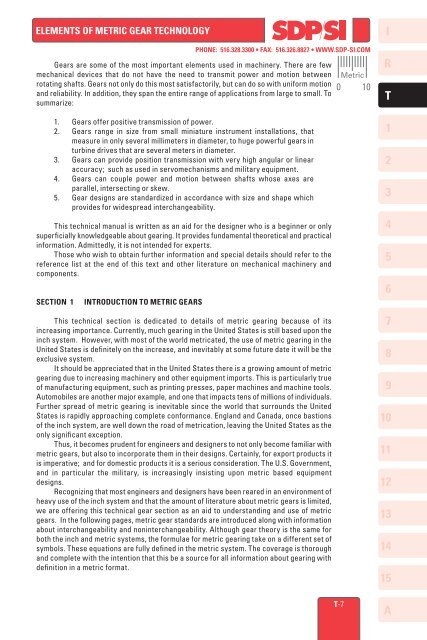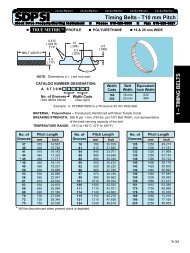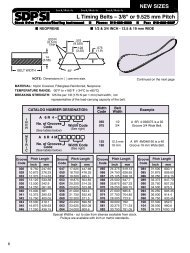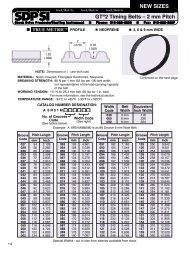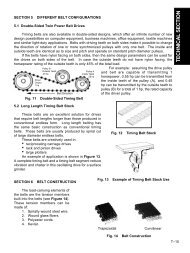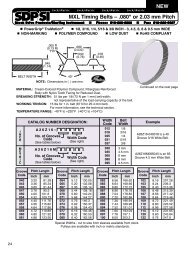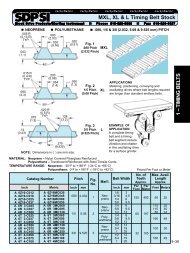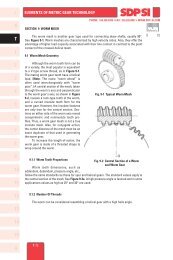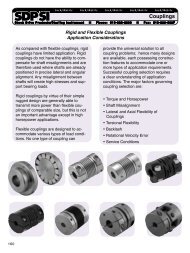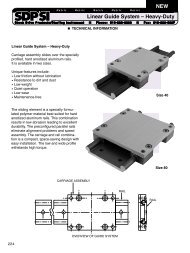I R 1 2 3 4 5 6 7 8 9 10 11 12 13 T 14 15 A - SDP/SI
I R 1 2 3 4 5 6 7 8 9 10 11 12 13 T 14 15 A - SDP/SI
I R 1 2 3 4 5 6 7 8 9 10 11 12 13 T 14 15 A - SDP/SI
Create successful ePaper yourself
Turn your PDF publications into a flip-book with our unique Google optimized e-Paper software.
ELEMENTS OF METRIC GEAR TECHNOLOGY<br />
PHONE: 516.328.3300 • FAX: 516.326.8827 • WWW.<strong>SDP</strong>-<strong>SI</strong>.COM<br />
Gears are some of the most important elements used in machinery. There are few<br />
mechanical devices that do not have the need to transmit power and motion between<br />
rotating shafts. Gears not only do this most satisfactorily, but can do so with uniform motion<br />
and reliability. In addition, they span the entire range of applications from large to small. To<br />
summarize:<br />
1. Gears offer positive transmission of power.<br />
2. Gears range in size from small miniature instrument installations, that<br />
measure in only several millimeters in diameter, to huge powerful gears in<br />
turbine drives that are several meters in diameter.<br />
3. Gears can provide position transmission with very high angular or linear<br />
accuracy; such as used in servomechanisms and military equipment.<br />
4. Gears can couple power and motion between shafts whose axes are<br />
parallel, intersecting or skew.<br />
5. Gear designs are standardized in accordance with size and shape which<br />
provides for widespread interchangeability.<br />
This technical manual is written as an aid for the designer who is a beginner or only<br />
superficially knowledgeable about gearing. It provides fundamental theoretical and practical<br />
information. Admittedly, it is not intended for experts.<br />
Those who wish to obtain further information and special details should refer to the<br />
reference list at the end of this text and other literature on mechanical machinery and<br />
components.<br />
SECTION 1<br />
INTRODUCTION TO METRIC GEARS<br />
This technical section is dedicated to details of metric gearing because of its<br />
increasing importance. Currently, much gearing in the United States is still based upon the<br />
inch system. However, with most of the world metricated, the use of metric gearing in the<br />
United States is definitely on the increase, and inevitably at some future date it will be the<br />
exclusive system.<br />
It should be appreciated that in the United States there is a growing amount of metric<br />
gearing due to increasing machinery and other equipment imports. This is particularly true<br />
of manufacturing equipment, such as printing presses, paper machines and machine tools.<br />
Automobiles are another major example, and one that impacts tens of millions of individuals.<br />
Further spread of metric gearing is inevitable since the world that surrounds the United<br />
States is rapidly approaching complete conformance. England and Canada, once bastions<br />
of the inch system, are well down the road of metrication, leaving the United States as the<br />
only significant exception.<br />
Thus, it becomes prudent for engineers and designers to not only become familiar with<br />
metric gears, but also to incorporate them in their designs. Certainly, for export products it<br />
is imperative; and for domestic products it is a serious consideration. The U.S. Government,<br />
and in particular the military, is increasingly insisting upon metric based equipment<br />
designs.<br />
Recognizing that most engineers and designers have been reared in an environment of<br />
heavy use of the inch system and that the amount of literature about metric gears is limited,<br />
we are offering this technical gear section as an aid to understanding and use of metric<br />
gears. In the following pages, metric gear standards are introduced along with information<br />
about interchangeability and noninterchangeability. Although gear theory is the same for<br />
both the inch and metric systems, the formulae for metric gearing take on a different set of<br />
symbols. These equations are fully defined in the metric system. The coverage is thorough<br />
and complete with the intention that this be a source for all information about gearing with<br />
definition in a metric format.<br />
Metric<br />
0 <strong>10</strong><br />
T-7<br />
I<br />
R<br />
T<br />
1<br />
2<br />
3<br />
4<br />
5<br />
6<br />
7<br />
8<br />
9<br />
<strong>10</strong><br />
<strong>11</strong><br />
<strong>12</strong><br />
<strong>13</strong><br />
<strong>14</strong><br />
<strong>15</strong><br />
A


